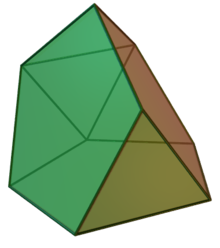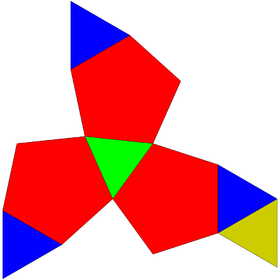Tridiminished icosahedron
| Tridiminished icosahedron | |
|---|---|
 | |
| Type | Johnson J62 – J63 – J64 |
| Faces | 5 triangles 3 pentagons |
| Edges | 15 |
| Vertices | 9 |
| Vertex configuration | |
| Symmetry group | |
| Properties | convex, non-composite |
| Net | |
 | |
In geometry, the tridiminished icosahedron is a Johnson solid that is constructed by removing three pentagonal pyramids from a regular icosahedron.
Construction
The tridiminished icosahedron can be constructed by removing three regular pentagonal pyramid from a regular icosahedron.[1] The aftereffect of such construction leaves five equilateral triangles and three regular pentagons.[2] Since all of its faces are regular polygons and the resulting polyhedron remains convex, the tridiminished icosahedron is a Johnson solid, and it is enumerated as the sixty-third Johnson solid .[3] This construction is similar to other Johnson solids as in gyroelongated pentagonal pyramid and metabidiminished icosahedron.[1]
The tridiminished icosahedron is non-composite polyhedron, meaning it is convex polyhedron that cannot be separated by a plane into two or more regular polyhedrons.[4]
Properties
The surface area of a tridiminished icosahedron is the sum of all polygonal faces' area: five equilateral triangles and three regular pentagons. Its volume can be ascertained by subtracting the volume of a regular icosahedron with the volume of three pentagonal pyramids. Given that is the edge length of a tridiminished icosahedron, they are:[2]
See also
- Snub 24-cell, a 4-polytope whose vertex figure is a tridiminished icosahedron
References
- ^ a b Gailiunas, Paul (2001), "A Polyhedral Byway" (PDF), in Sarhangi, Reza; Jablan, Slavik (eds.), Bridges: Mathematical Connections in Art, Music, and Science, Bridges Conference, pp. 115–122.
- ^ a b Berman, Martin (1971), "Regular-faced convex polyhedra", Journal of the Franklin Institute, 291 (5): 329–352, doi:10.1016/0016-0032(71)90071-8, MR 0290245.
- ^ Francis, Darryl (August 2013), "Johnson solids & their acronyms", Word Ways, 46 (3): 177
- ^ Timofeenko, A. V. (2009), "Convex Polyhedra with Parquet Faces" (PDF), Docklady Mathematics, 80 (2): 720–723, doi:10.1134/S1064562409050238.
External links
- Weisstein, Eric W., "Tridiminished icosahedron" ("Johnson Solid") at MathWorld.
- v
- t
- e
- elongated triangular pyramid
- elongated square pyramid
- elongated pentagonal pyramid
- gyroelongated square pyramid
- gyroelongated pentagonal pyramid
- triangular bipyramid
- pentagonal bipyramid
- elongated triangular bipyramid
- elongated square bipyramid
- elongated pentagonal bipyramid
- gyroelongated square bipyramid
- elongated triangular cupola
- elongated square cupola
- elongated pentagonal cupola
- elongated pentagonal rotunda
- gyroelongated triangular cupola
- gyroelongated square cupola
- gyroelongated pentagonal cupola
- gyroelongated pentagonal rotunda
- gyrobifastigium
- triangular orthobicupola
- square orthobicupola
- square gyrobicupola
- pentagonal orthobicupola
- pentagonal gyrobicupola
- pentagonal orthocupolarotunda
- pentagonal gyrocupolarotunda
- pentagonal orthobirotunda
- elongated triangular orthobicupola
- elongated triangular gyrobicupola
- elongated square gyrobicupola
- elongated pentagonal orthobicupola
- elongated pentagonal gyrobicupola
- elongated pentagonal orthocupolarotunda
- elongated pentagonal gyrocupolarotunda
- elongated pentagonal orthobirotunda
- elongated pentagonal gyrobirotunda
- gyroelongated triangular bicupola
- gyroelongated square bicupola
- gyroelongated pentagonal bicupola
- gyroelongated pentagonal cupolarotunda
- gyroelongated pentagonal birotunda
- augmented truncated tetrahedron
- augmented truncated cube
- biaugmented truncated cube
- augmented truncated dodecahedron
- parabiaugmented truncated dodecahedron
- metabiaugmented truncated dodecahedron
- triaugmented truncated dodecahedron
- gyrate rhombicosidodecahedron
- parabigyrate rhombicosidodecahedron
- metabigyrate rhombicosidodecahedron
- trigyrate rhombicosidodecahedron
- diminished rhombicosidodecahedron
- paragyrate diminished rhombicosidodecahedron
- metagyrate diminished rhombicosidodecahedron
- bigyrate diminished rhombicosidodecahedron
- parabidiminished rhombicosidodecahedron
- metabidiminished rhombicosidodecahedron
- gyrate bidiminished rhombicosidodecahedron
- tridiminished rhombicosidodecahedron


















